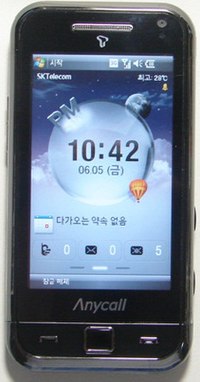This article has multiple issues. Please help improve it or discuss these issues on the talk page . (Learn how and when to remove these messages)
|
 | |
 | |
| Manufacturer | Samsung |
|---|---|
| Series | Samsung Omnia Series |
| Availability by region | 2008 |
| Discontinued | 2009-10 |
| Successor | Samsung i8000 Omnia II |
| Compatible networks | AGPS, HSDPA (3.5G), Quad band GSM / GPRS / EDGE GSM 850, GSM 900, GSM 1800, GSM 1900 |
| Form factor | Candybar |
| Dimensions | 112 x 56.9 x 12.5 mm |
| Weight | 127 g |
| Operating system | Microsoft Windows Mobile 6.1 Professional |
| CPU | 624MHz Marvell PXA312 processor. |
| Memory | 128 MB RAM, 256 MB ROM |
| Storage | 8 GB/16 GB |
| Removable storage | MicroSD (TransFlash) |
| Battery | Li-Ion (1440 mAh) |
| Rear camera | 5 Megapixels (Back) and VGA Video Recording |
| Front camera | 3G Video Calling (Front) |
| Display | 240x400 px (rotatable), 3.2 in, TFT LCD, Touch Screen |
| Connectivity | USB 2.0, Bluetooth 2.0 with A2DP, Wi-Fi b/g, |
| Data inputs | Touchscreen, Optical “Finger-Mouse” sensor, Buttons |
| Codename | GrandPrix |
| Hearing aid compatibility | M4 [1] |
The Samsung SGH-i900, also known as Omnia I or WiTu [2] (in Russia only), is a smartphone created by Samsung Mobile. Announced in June 2008, the Omnia was launched in Singapore in mid-June, available in stores on the 20th of June, and in the rest of Asia in July. For some parts of Europe, it was launched in August. It was made available for the United States in December 2008 through Verizon Wireless [3] and for Canada in April 2009 through Telus Mobility.
Contents
- Camera
- Korean edition (T*Omnia)
- Japanese edition (930SC)
- North American edition (SCH-i910)
- Verizon software update
- Omnia II (GT-i8000)
- TMC
- See also
- References
- External links
The Omnia was Samsung Mobile's top-of-the-line flagship handset. It runs on Windows Mobile 6.1 Professional, but comes other applications preinstalled to make its GUI and its functions distinguishable from others running the same platform:
- Samsung Today Screen 1 (alternative home screen UI)
- Samsung Today Screen 2 (similar to Samsung Today Screen 1)
- Samsung Touch Wiz UI (alternative application menu with a widget bar and widgets)
All these applications have the ability to be controlled by sliding the finger across the screen. The third Today Screen has gained interest because of its control method. It uses about a fourth of the screen on the left side to hold a bar of widgets that can be scrolled up and down. The rest of the screen is customizable, as widgets can be pulled out of the sidebar and onto the main screen to be expanded for quick use.

